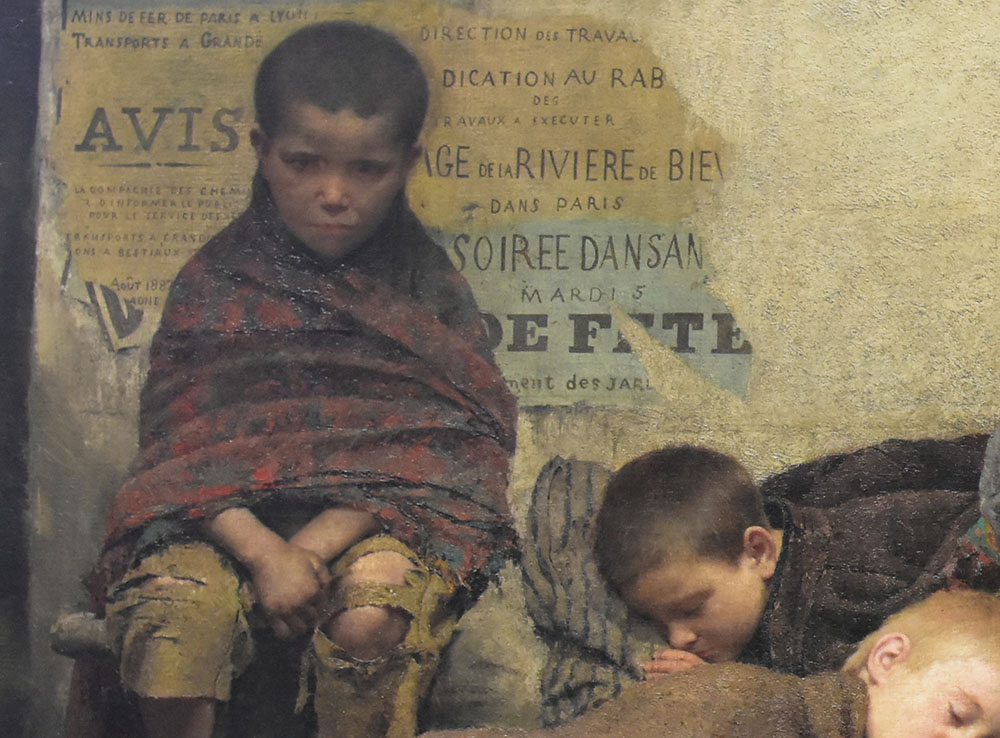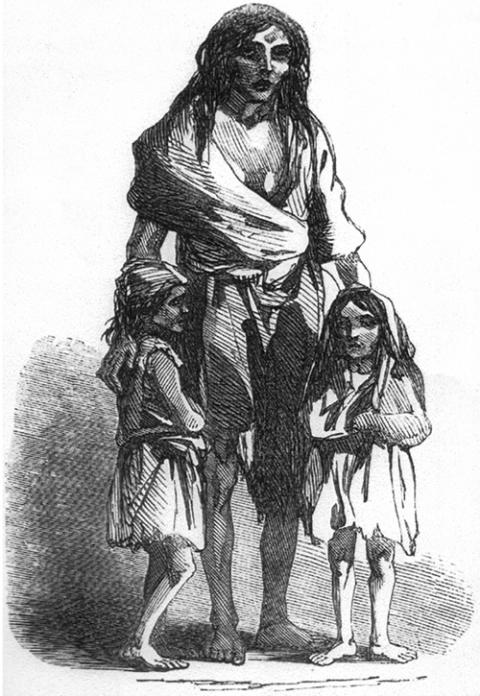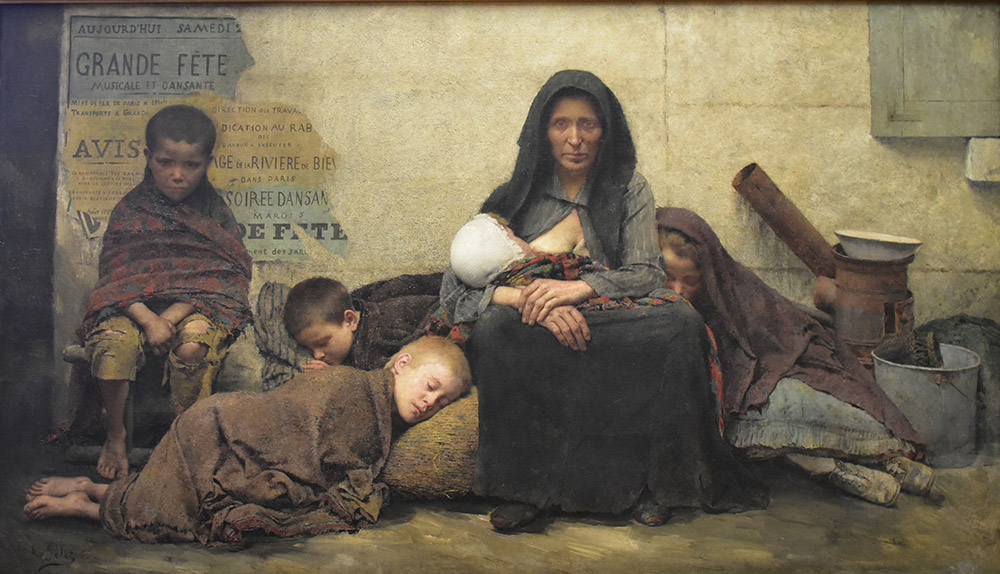
Detail from "Homeless," an 1883 painting by Fernand Pelez (Wikimedia Commons)
Fifty years ago, Linda Nochlin challenged the patriarchal structure of Western art history with one question: "Why have there been no great women artists?"
Earlier this year, Thames & Hudson honored her legacy and published a 50th-anniversary edition of Why Have There Been No Great Women Artists?, printed alongside Nochlin's 2001 update, "Thirty Years After."
In the essay, originally published within the pages of ArtNews, Nochlin created a line of inquiry that cut directly into the core of the male-dominated Western canon. She forced her readers to question their ideas about gender, greatness and art. Nochlin applied second-wave feminism to mainstream art and art history for the first time.
She resisted the urge to dust off a few paintings forgotten in history and coronate their female creators as artistic geniuses. Instead, she created a methodology for institutional critique through the lens of gender — a method that would become the basis of feminist art history. She crafted a hermeneutic integral to the field today.
Nochlin's work throughout the years has inspired many others to ask similar questions of the art world. In 1989, the Guerilla Girls asked: "Do women have to be naked to get into the Met. Museum?" noting that "less than 5% of artists in the Modern Art Sections are women, but 85% of the nudes are female."
Shortly after her death in 2017, Nochlin posthumously published Misère: The Visual Representations of Misery in the 19th Century.
Advertisement
Nochlin's book was not a survey but instead "an examination of case studies and paradigms." Misère, she notes, Thomas Aquinas distinguished from poverty as the lack of the necessary, as opposed to just the absence of superfluity. She borrows from the 19th-century French sociologist Eugène Buret for her definition of misère: "poverty felt morally."
The late historian analyzes how the emergence of the Industrial Revolution and the modern cities that came along with it in the 19th century built misère into the very structure of society. Unlike 20th-century artists working in abstraction to capture "unrepresentability" in response to the horrors of worldwide wars, European artists in the 19th century focused their energy on accurately representing "outrage, oppression and misery" in response to their own changing social and economic conditions.
Nochlin's first case study is "The Irish Paradigm," which visualizes the potato famine, as it is known colloquially here in the United States, or more accurately called in Ireland, An Gortá Mór, "the Great Hunger."
"In the case of written reports as well as the visual arts, it is not so much a question of the representation of misery in Ireland, but of the representation of Ireland as misery," writes Nochlin.

James Mahony's 1849 "Sketch of a Woman and Children (Bridget O'Donnel and Her Children)" (Wikimedia Commons)
A religious imagination is useful for understanding this material. She describes James Mahony's "Boy and Girl at Cahera" from the Illustrated London News, Feb. 20, 1847, as misery incarnate, precursors to the soon-to-be-developed field of documentary photography. She compares his "Sketch of a Woman and Children (Bridget O'Donnel and Her Children)" to the Virgin of Mercy prototype, and his "Woman Begging at Clonakilty" to the pietà.
Marian imagery appears on the cover with Fernand Pelez's "Homeless" (1883) discussed in Chapter 5, and reappears in her chapter exploring Gustave Courbet's Irish beggar woman in "The Painter's Studio" (1854-55). She labels the woman seated on the floor at the foot of the painter's easel as a "secular, nontranscendent updating of the Madonna of Humility."
Courbet returned to this haggard figure again and again, exploring how best to embody misery in the modern world.
One interesting, if perhaps unresolved, through line in the book is Nochlin's engagement with Martha Rosler's late-20th-century critique of the documentary style. Rosler questioned the morality of a documentary vision born out of the 19th century. Documentary photography often belittles its subjects, the representation of "the homeless and dispossessed is outworn, ineffective and a powerless and imagistic cliché."
Rosler's practice offers language as a more just means of representation — a solution Nochlin finds unconvincing. Rosler's text-based diptychs are potent, but speak to a select in-group that know and understand the history of photography. With their intellectual exclusivity, they lack the power to move the masses.
Masses need to move for change to happen, for compassion to triumph over capitalism.
Art encourages empathy, it stops us in our tracks and has us look at something beyond ourselves. We can use art to document, analyze and process the misery and suffering in the world around us. It helps us to make sense of pain that feels senseless. It reminds us that our liberation is tied to one another.
Nochlin's question of how we visualize misery feels more interesting, relevant and of the moment now in 2021 than it did even just a few short years ago at its publication in 2018. The onslaught of a global pandemic over the course of the past year and a half has unflinchingly exposed the miserable core of our own rotting system.

"Homeless" (1883) by Fernand Pelez (Wikimedia Commons)
But her 19th-century-focused book leaves us with a burning question — how ought we depict misery today?
As Nochlin discussed Pelez's images of children as figures of misère, my mind turned to the silver screen. I thought back to the kids from Sean Baker's delicate 2017 film "The Florida Project" and young Chiron, or "Little," from Act 1 of Barry Jenkins' luminary 2016 film, "Moonlight."
Film today exists in a similarly liminal space between high and low art that print as a medium occupied during the 19th century. Like artists of that period, contemporary filmmakers directly engage with this idea of misery. In 2019, Jordan Peele's pop horror "Us," and Bong Joon-ho's universally beloved "Parasite" both explored widening inequality through an upstairs/downstairs class consciousness that was — to quote the protagonist of "Parasite" — "wow ... so metaphorical."
One of this year's most lauded movies, Chloé Zhao's "Nomadland," returns to the realist tradition and its critique of capitalism. On his allegiance to the cause of social radicalism, Nochlin cites Courbet as writing, " 'Realist' means a sincere lover of the honest truth." Zhao picks up the baton from Courbet with her portrait of Fern, a woman who turns to van life after losing everything in the great recession.
Zhao captures Fern beautifully, honestly and lovingly, but never sentimentally. Enormous Amazon logos on the side of the warehouses Fern returns to throughout the film remind us that her poverty is someone else's profit.
We cannot avert our gaze from the poor, the disenfranchised, the miserable. We must look and bear witness to the reality of our system's rotten core.
Misery must be visually represented, not to merely wallow in despair but to condemn the structures of society that enable it. In the words of Nochlin, so that we can work toward the "insaturation of a more just, egalitarian and satisfying social order for all."







